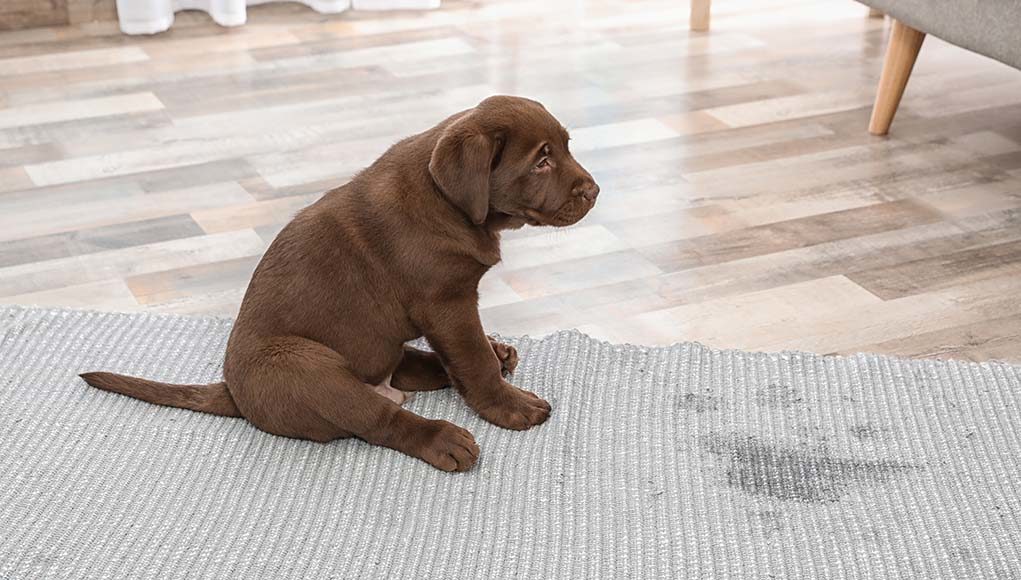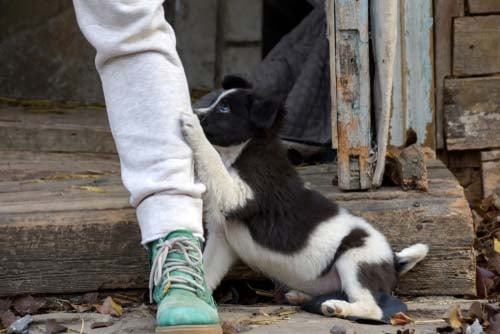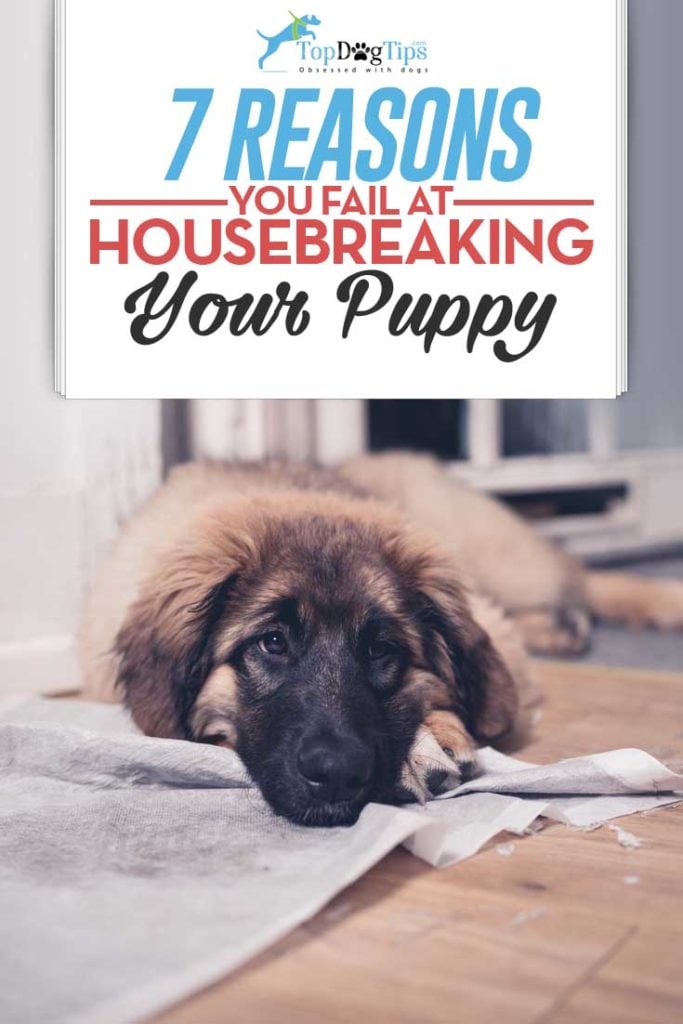Housebreaking a puppy can be frustrating and may seem hopeless when all your efforts are failing.
If your dog isn’t picking up the training or has developed a hard-to-fix bad habit, don’t give up just yet – there are a few additional things you can do.
One the biggest mistakes new owners make when housebreaking a puppy is using methods that are actually hindering a puppy’s learning process.
Here's how to prevent this and how to fix the problems that you're currently dealing with.f
Housebreaking a Puppy: 7 Mistakes
1 You (Unintentionally) Punish Your Puppy
Punishing a dog for making what you consider a mistake can be detrimental when housebreaking a puppy.
For example, when a dog goes potty in front of you, and you express anger over this, the dog learns that it's bad to pee in front of you.
The dog's next instinct then will be to simply find a different place (like under a table or on the bed) to go potty, where you cannot see them doing it.
Some owners punish or shout at the dog on purpose, while others may express their anger unintentionally.
While it's certainly frustrating, maintaining your cool composure will actually bring you closer to successfully housebreaking a puppy.
How to fix this:
Instead of making a scene when you see your puppy peeing in the wrong place, do something to startle the dog without scaring them (for example, loudly clap your hands and follow up with “No”).
This will make your pet stop going in the moment.
When the dog stops, pick them up and carry your puppy outside (or onto a pee pad if you're using them). When the dog regains their bearings, they'll wander around and find a place to finish the business.
Do this even if your puppy has stopped going inside the house, as it will get them used to the fact of going outside.
This will take many attempts, but eventually, your pup will get conditioned as all dogs are.
2 You Leave Your Puppy's Food Out All Day
Free feeding is a concept that has its place among pet owners, but it can also have a negative impact when housebreaking a puppy, because it doesn't keep the dog on a schedule.
A schedule ensures your dog learns specific potty times, and when training a young dog, this is especially important – routine is one of the key aspects of effective housetraining.
Always keep your puppy on schedule, whether it's for feeding, housebreaking or other training matters.
This helps to predict when the dog has to go out, among other things.
Free feeding needs to be practiced only for specific reasons and with a good understanding of this concept, because it can lead to health problems, including obesity.
How to fix this:
Simply feed your puppy twice a day – once in the morning and once at night.
Typically, puppies need to go potty first thing in the morning, 30 minutes after they eat, after they nap and right before they are left alone for the night.
When they are young or you are just starting out with puppy housebreaking, the young dog should be taken out every 30 to 60 minutes.
As they get bigger and their bladders grow, you can gradually increase the time between bathroom breaks.
3 You're Using Ammonia-based Cleaner
Ammonia is a bad choice for cleaning up pet urine stains for two reasons.
First, ammonia is what's a dog's pee made of (among other things).
As the urine is breaking down, concentration levels of ammonia will increase and compound known as mercaptans is produced, quickly spreading through the air.
The scent of ammonia coming from a place you've just cleaned up will send a signal to the dog that it's fine to pee in that same previously-peed-on spot again.
This is why dogs keep instinctively marking and remarking their territories.
Second reason is that ammonia is high in alkaline, so it's not only bad for housebreaking your puppy but also bad for your carpets.
The odor isn't good for you to breathe in either. Ammonia also leaves a residue, which can last for a very long time.
How to fix this:
Many pet urine eliminators are available, but all-natural enzymatic cleaners are the best for getting rid of urine stains on carpets or furniture.
They will break down the proteins in the urine and take away the scent, so your puppy won’t be inclined to go there again.
Some dog urine cleaners are even specifically designed not only to get rid of stains and smell but also to discourage the dog from using that spot again.
Alternatively, you can also use some homemade cleaners to get a dog's pee out of carpet.
Tip: It's easy to miss a spot where your puppy urinated, which means it's likely they will pee there again. The easiest way to find those accident spots is with a pet urine detector, which is essentially a black-light.
4 You're Not Patient Enough
While you won't need to be concerned with this for the rest of your dog's life, the beginning is certainly the hardest.
As you may have already noticed, housebreaking a puppy can be difficult sometimes, and the process needs a high level of dedication and patience to be successful.
House-training process can take anywhere from 2 to 6 months.
Become content with the fact that it's not going to happen overnight.
It takes not only time but also energy, consistent effort and patience, especially when your dog is having trouble picking up the training due to some of the other mistakes on this list.
How to fix this:
The only way to fix this is to stick with it and be patient, avoiding all these puppy housebreaking mistakes mentioned here.
While most puppies are usually housetrained within 2 to 6 months, some dogs can take up to a year to finally pick it up.
Cutting corners will only lead to the process of taking longer, and may even case the dog to develop poor behavioral habits.
5 You Leave It Up to Dog's Instincts
Is there any chance that you leave your puppy to learn the process of housebreaking by themselves, either due to your lack of patience, time constraints or simply laziness?
Do you simply open the door and let the dog go potty? This may be one of the reasons why they're not learning well.
Your logic here may be that these are dogs, and they should know how to do their business outside.
You'd think they don’t need supervision and their instincts will guide them.
Unfortunately, that's wrong.
This may work for dogs in the nature where details wouldn't matter, but when housebreaking a puppy, you always have to be in control.
How to fix this:
Puppies need supervision. A big part of puppy housebreaking training is constant positive reinforcement.
For positive reinforcement to be effective, it has to be given immediately after the good deed (going potty in the right spot) has been done.
Always show your dog when they've done good. Be overly enthusiastic with your praise. Occasionally, you can throw in some treats.
Another trick is to always keep your dog close to you when potty training, even in the house. When the puppy is confined to a room with you, it's easier to spot the “potty signs.”
6 You Miss the Potty Tell-Tale Signs
If you are new to owning a dog, you may not know when your pup needs to go out and miss the warning signs.
Understanding your puppy's body language is key.
If the dog can’t hold it anymore, they will have an accident.
Some common warning signs your puppy needs to go potty include:
- Waiting by the door
- Constant pacing
- Excessive barking
- Whining
- Circling about
- Trying to hide
- Sniffing around (for a good place to go)
How to fix this:
Observe your dog and learn about their body language. All dogs are different but they do share many similar signs.
Note specific behaviors that are clear signs your puppy needs to use the bathroom.
Take action as soon as you see these signals.
How often a puppy needs to pee depend on their age and size.
Small dogs have smaller bladders and higher metabolisms, so they have to go more frequently than large breeds.
Young dogs and elderly dogs go more often than adult dogs, too.
7Optional: You're Not Using a Dog Crate
Some dogs love crates, others hate them. And it's the same with dog owners and their view of crates. This is similar to using pee pads – for some dogs, it's better, while for others, it's a big mistake to use pee pads when housebreaking.
Nevertheless, crate training can sometimes be an extremely effective housebreaking tool, especially if leaving a dog alone for a period of time.
So if housebreaking hasn't been working for you so far, buy a crate and try setting up a puppy crate training schedule.
How to fix this:
First, you'll need to get a good dog crate to confine your puppy to a space where they are not going to eliminate. Picking the right type of crate is very important part, and so is choosing the right size.
For puppies, it's generally better to use plastic crates or metal crates with a divider – it'll be easier to clean potty mess, and they can be adjusted for size as the puppy grows.
Always measure your dog before buying a crate. It has to be big enough for the dog to be comfortable, but at the same time not too large.
A crate that's too big will often result in a dog pooping or peeing in a crate, because they tend to separate the area into two parts: one for sleeping, one for bathroom.
READ NEXT: 15 Tips on How to Housebreak a Puppy at Home (Using Pee Pads)

















